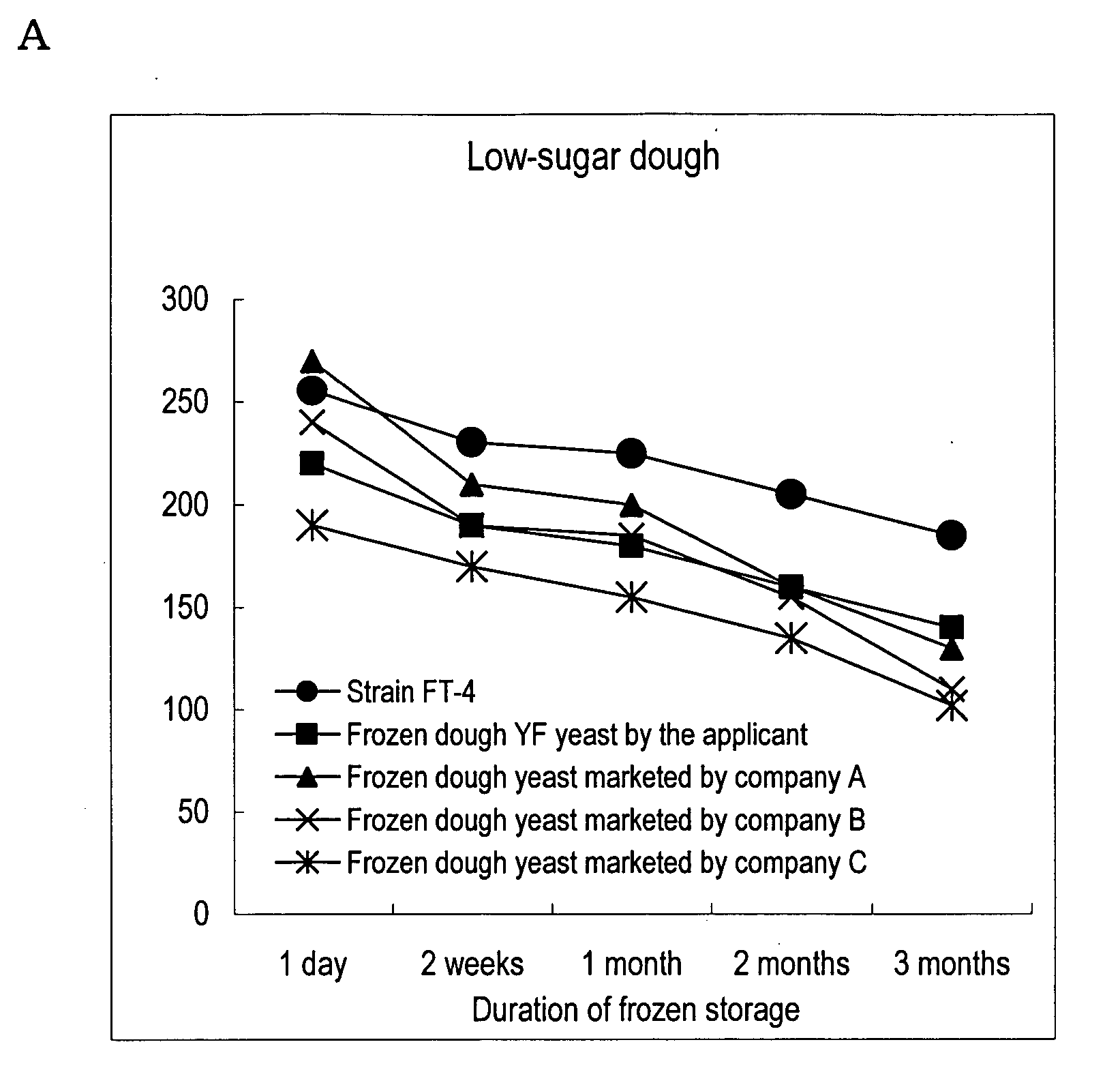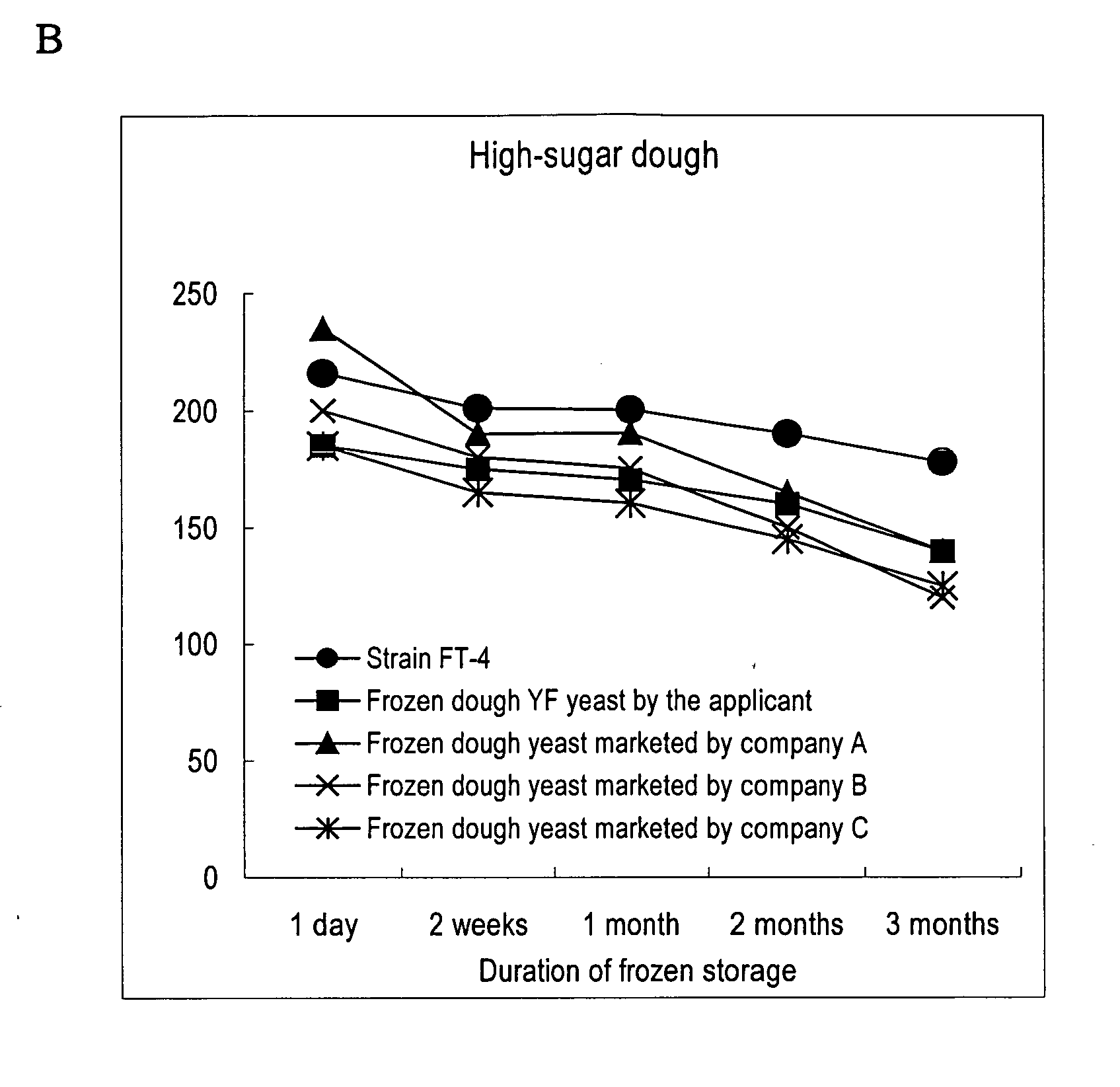Novel bakers yeast strains and bread made using the same
a technology of yeast and bread, applied in the field of new bakers yeast strains, can solve the problems of time required, unpleasant bread flavor, and more unpleasant bread flavor, and achieve the effects of excellent flavor, and weak offensive taste and odor characteristic of yeas
- Summary
- Abstract
- Description
- Claims
- Application Information
AI Technical Summary
Benefits of technology
Problems solved by technology
Method used
Image
Examples
example 1
Breeding and Screening of Saccharomyces cerevisiae Strain FT-4
[0024] Spores of a diploid yeast strain (the applicant's YF yeast) belonging to Saccharomyces cerevisiae which was at least highly freeze-tolerant were germinated to obtain a monoploid yeast strain. Likewise, spores of a diploid yeast strain (the applicant's sake yeast) belonging to Saccharomyces cerevisiae which was not freeze-tolerant, but whose offensive taste and odor characteristic of yeast was weak were germinated to obtain another monoploid yeast strain. These monoploid yeast strains were crossed via sexual reproduction to give a large number of diploid yeast strains.
[0025] Subsequently, primary screening for freeze tolerance was performed on these strains. YPD liquid medium (3 ml) was introduced into 13 ml tubes, sterilized at 121° C. for 15 minutes and then inoculated with a loopful of each strain, followed by shaking culture at 30° C. for 20 hours. The resulting yeast cells of each strain were collected by cen...
example 2
Comparison of isobutyric acid Content
[0031] A loopful of the strain FT-4 or bakers' yeast strains marketed by various companies was inoculated into a 500 ml baffled Erlenmeyer flask containing 100 ml YPD liquid medium and then grown in shaking culture at 30° C. for 20 hours. The cultured solutions were each centrifuged at 3,000 rpm for 5 minutes to collect the cells, followed by washing twice with sterilized distilled water. The resulting washed yeast cells were frozen and stored. The freeze-dried yeast cells were reconstituted with cold water and adjusted to a solid content of 20%, followed by addition of 10% glass beads to disrupt the yeast cells by vortexing at high speed. After centrifugation at 10,000 rpm for 10 minutes, the supernatant was measured for its isobutyric acid content by gas chromatography to determine an isobutyric acid content calculated on a dry cell basis for each strain.
[0032] Table 3 shows the measured results. The strain of the present invention had an iso...
example 3
Fermentability in Non-Frozen Doughs
[0033] In accordance with the following steps, cells of the strain FT-4 were cultured in a 300 L jar fermentor and used for measurement of the fermentability in non-frozen doughs using the method of the Japan Yeast Industry Association.
Culture of the Strain FT-4
(1) Culture of Seed Yeast
[0034] A loopful of the strain FT-4 was seeded into a 500 ml baffled Erlenmeyer flask containing 200 ml YPD liquid medium and then grown in shaking culture at 30° C. for 24 hours. The cultured solution was then inoculated into a 30 L jar fermentor containing 15 L molasses medium (see Table 4) and grown under the conditions shown in Table 4 to give seed yeast for 300 L jar fermentor culture.
(2) 300 L jar Fermentor Culture
[0035] The main culture medium shown in Table 4 was prepared in a volume of 150 L in a 300 L jar fermentor and inoculated with the whole volume of the seed culture grown in a 30 L jar fermentor, followed by culture under the following conditi...
PUM
 Login to View More
Login to View More Abstract
Description
Claims
Application Information
 Login to View More
Login to View More - R&D
- Intellectual Property
- Life Sciences
- Materials
- Tech Scout
- Unparalleled Data Quality
- Higher Quality Content
- 60% Fewer Hallucinations
Browse by: Latest US Patents, China's latest patents, Technical Efficacy Thesaurus, Application Domain, Technology Topic, Popular Technical Reports.
© 2025 PatSnap. All rights reserved.Legal|Privacy policy|Modern Slavery Act Transparency Statement|Sitemap|About US| Contact US: help@patsnap.com



